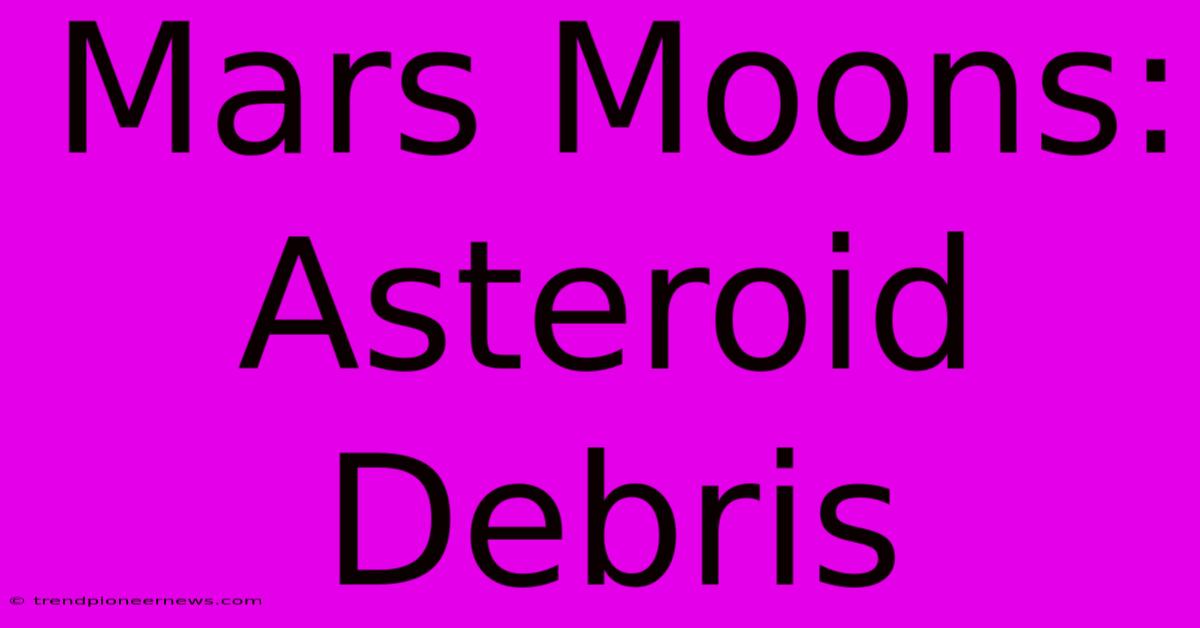Mars Moons: Asteroid Debris

Discover more detailed and exciting information on our website. Click the link below to start your adventure: Visit Best Website Mars Moons: Asteroid Debris. Don't miss out!
Table of Contents
Mars Moons: Captured Asteroid Debris? A Look at Phobos and Deimos
Hey everyone! So, you're curious about Mars' moons, Phobos and Deimos? I was too, and let me tell you, it's a fascinating rabbit hole. I mean, seriously, these things are weird. They look nothing like our nice, round moon. They're kinda... lumpy. And that's where the whole "captured asteroid" theory comes in.
My Initial Misconceptions (and How I Learned Better!)
Initially, I thought, "Duh, moons orbit planets. That's it." Simple, right? Wrong! I dove headfirst into researching planetary formation, and man, was I in for a surprise. I spent hours reading scientific papers – some of which went completely over my head, I'll admit – trying to wrap my brain around accretion disks and gravitational capture. It was frustrating at times; I felt like I was learning a new language!
One huge misconception I had was that all moons form with their planets. It turns out that's not always the case. Many moons, including Phobos and Deimos, are thought to be captured asteroids. What does that even mean, you ask? Let's dive in!
The Captured Asteroid Hypothesis: What's the Deal?
The leading hypothesis suggests that Phobos and Deimos are captured asteroids from the asteroid belt. They're small, irregularly shaped, and their composition is similar to D-type asteroids – a class of asteroids found in the outer regions of the asteroid belt. This composition analysis is key evidence supporting the theory.
Imagine this: Mars' gravity, over millions of years, snagged these asteroids as they passed by. It wasn't a gentle embrace, either; it probably involved some serious gravitational tug-of-war!
This theory is supported by several observations, including their relatively low mass and their orbital characteristics, which aren't perfectly circular. This is really important to understand!
It's not a perfectly settled debate, of course. There's always room for more research and refinement in this field! The scientific community continues to gather evidence to support the hypothesis, or perhaps prove it incorrect.
Phobos and Deimos: A Closer Look
Phobos, the larger of the two, is only about 22 kilometers across. It's so close to Mars that it's actually spiraling inwards and will eventually crash into Mars or break apart. Crazy, right?!
Deimos, even smaller, is only about 12 kilometers in diameter and orbits farther away from Mars. It's moving away from Mars, slowly but surely.
These moons show clear evidence of cratering and are fairly dark, reflecting relatively little sunlight. The composition of both moons, and their orbital characteristics, are what makes the "captured asteroid" hypothesis so compelling.
Actionable Insights for Aspiring Space Enthusiasts
So, what have I learned from this whole journey? Well, firstly, space is weird. Secondly, scientific understanding is constantly evolving. I mean, scientists were wrong about a whole lot of stuff for years! The universe is full of surprises, and what we know today might be refined or even overturned by new evidence tomorrow.
Here's the takeaway: Don't be afraid to ask questions, even if they seem basic. Dive into the research – even if it's challenging – because the journey of discovery is as rewarding as the destination. And hey, maybe you'll uncover the next big thing in planetary science! Who knows?
Remember, my journey into understanding the Martian moons is ongoing. There's always more to learn. What about you? What are some space mysteries that intrigue you? Let’s discuss in the comments!
Keywords: Mars moons, Phobos, Deimos, captured asteroids, asteroid belt, planetary formation, space exploration, D-type asteroids, orbital characteristics, gravitational capture, space science, astronomy, planetary science.

Thank you for visiting our website wich cover about Mars Moons: Asteroid Debris. We hope the information provided has been useful to you. Feel free to contact us if you have any questions or need further assistance. See you next time and dont miss to bookmark.
Featured Posts
-
Sa Vs Sl 1st Test Live Score
Nov 27, 2024
-
Martian Moons Origin Explained
Nov 27, 2024
-
Rod Stewart At Glastonbury
Nov 27, 2024
-
Where To Watch Sufc Oxford
Nov 27, 2024
-
Wednesday Decision Angers Hull Boss
Nov 27, 2024
